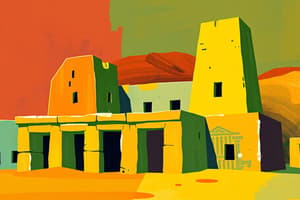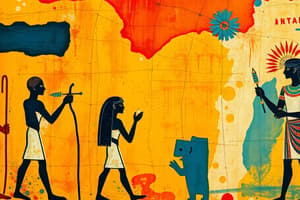Podcast
Questions and Answers
How did prehistoric art likely serve its creators in terms of communication or purpose?
How did prehistoric art likely serve its creators in terms of communication or purpose?
Prehistoric art likely served as a means of communication and possibly had religious significance.
What are the predominant colors used in Ancient Egyptian art and their source?
What are the predominant colors used in Ancient Egyptian art and their source?
The predominant colors in Ancient Egyptian art included red, black, blue, gold, and green, derived from durable mineral pigments.
Describe the fresco painting method used in Classical Greek art.
Describe the fresco painting method used in Classical Greek art.
Fresco painting involves applying water-based pigments on freshly applied plaster, allowing colors to become a permanent part of the wall.
What was a key characteristic of Romanesque art in relation to its use in churches?
What was a key characteristic of Romanesque art in relation to its use in churches?
What are the defining features of Baroque art?
What are the defining features of Baroque art?
What characterized the sculptures of the Egyptian era and how did they symbolize power?
What characterized the sculptures of the Egyptian era and how did they symbolize power?
Explain the evolution of Greek sculpture from its early forms to later representations.
Explain the evolution of Greek sculpture from its early forms to later representations.
What role did materials play in Romanesque sculptures, and give an example.
What role did materials play in Romanesque sculptures, and give an example.
Describe the themes often found in Byzantine sculptures, including an example.
Describe the themes often found in Byzantine sculptures, including an example.
How did the design of Gothic sculptures differ from earlier styles, and what was a notable feature of this period?
How did the design of Gothic sculptures differ from earlier styles, and what was a notable feature of this period?
Flashcards are hidden until you start studying
Study Notes
Prehistoric Era Art
- Prehistoric art found in caves, likely for communication or religious purposes.
- Accurate depictions of animals in cave drawings, showcasing artistic skill.
- The Cave of Lascaux features large regional animals, significant to cultural context.
Ancient Egyptian Art
- Aimed to create a pleasant afterlife, emphasizing life beyond death.
- Art is highly stylized, symbolic, typically showing profile views of figures and animals.
- Common colors: red, black, blue, gold, and green from mineral pigments.
Classical Greek Art
- Depicted dynamic compositions with natural figures, including battles and mythology.
- Demonstrated understanding of linear perspective and naturalistic representation.
- Prominent painting methods: fresco (water-based on plaster) and encaustic (pigments mixed with hot wax).
Greek Painting Techniques
- Fresco: Durable method, pigments applied to wet plaster, resulting in a matte finish ideal for murals.
- Encaustic: Originated from shipbuilding, using hot wax with added pigments for painting.
Greek Vase Painting (Kerch Style)
- Red-figured pottery discovered at Kerch, showcasing intricate designs.
- Varieties include:
- Pelike: Wine container.
- Lekanis: Low bowl with horizontal handles.
- Lebes gamikos: High-handled vessel for bridal baths.
- Krater: Bowl for mixing wine and water.
Roman Art
- Influenced by Greek styles, focusing on diverse subjects including landscapes.
- Mosaics composed of tiny materials used for decoration in structures.
Romanesque Art
- Characterized by mosaics in church walls, employing frontal poses.
Gothic Art
- Appeared in illuminated manuscripts, frescoes, and tapestries.
- Popular subjects included legends and love stories.
- Stained glass windows introduced to enhance interiors with colorful light and serve as Christian teaching tools.
Baroque Art
- Known for dramatic lighting and vibrant colors, conveying emotional intensity.
- Sculptures displayed dynamic movement and strong emotional expression.
Prehistoric Sculptures
- Venus of Willendorf: Limestone fertility charm with exaggerated features.
- Venus of Brassempouy: Ivory figurine showcasing a human face and hairstyle.
Egyptian Sculptures
- Used symbolic elements and hieroglyphics, with materials like wood, ivory, and stone.
- Queen Nefertiti: Painted limestone sculpture with realistic portrayal.
- Pharaoh Menkaure and His Queen: Rigid postures reflecting emotional simplicity.
Greek Sculptures
- Early sculptures were tense and draped, evolving to depict human anatomy and proportion.
- Myron's Discobulus: Represents maximum tension and athletic energy.
Roman Sculptures
- Made from monumental terra-cotta, focusing on narrative reliefs in triumphal columns.
Byzantine Sculptures
- Themes included religious motifs and everyday life; examples are represented in ivory work.
- The Barberini Diptych: Early example of Byzantine ivory craftsmanship.
Romanesque Sculptures
- Featured reliquaries, altar frontals, crucifixes, often using costly materials for patrons.
- Famous example: Last Judgment at Autun Cathedral's west portal.
Gothic Sculptures
- Greater stylistic freedom, with figures projecting outward from walls.
- Individual attitudes and lively representations; notable example: Resurrection of the Virgin.
Architectural Styles
Megalithic Architecture
- Comprised large stone structures: Menhirs (standing stones), Dolmens (stone tables), Cromlechs (stone circles).
- Stonehenge: A notable megalithic site for rituals and seasonal tracking.
Egyptian Architecture
- Developed circa 4000 BC, renowned for Pyramids of Giza as tombs for kings.
- Commonly featured Mastabas, flat-roofed rectangular tombs.
Greek Architecture
- Characterized by temples with central shrines and column designs.
- Utilized three architectural orders: Doric, Ionic, and Corinthian.
Studying That Suits You
Use AI to generate personalized quizzes and flashcards to suit your learning preferences.




